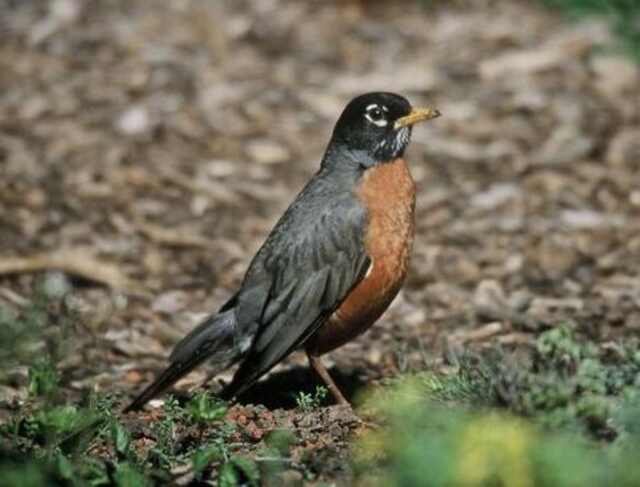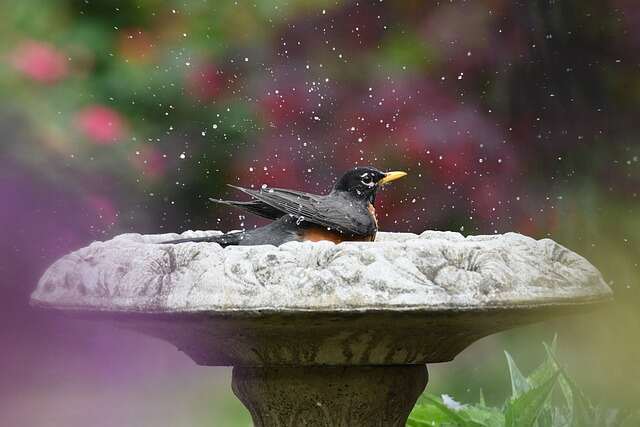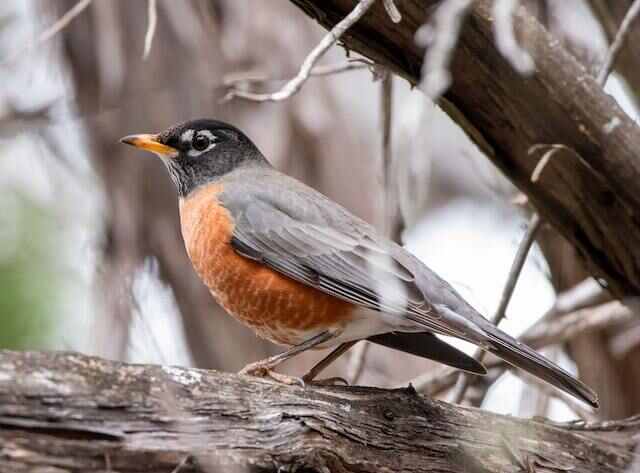Welcome to the world of American Robins! Known for their vibrant orange bellies and cheerful songs, these birds are a beloved sight in North American backyards. In this blog, we’ll explore fascinating American Robin facts, uncovering the secrets of their behavior, habitat, and unique traits. Whether you’re a birdwatching enthusiast or simply curious, join us to learn more about these captivating creatures and their remarkable lives.
Table of Contents
Physical Appearance and Habitat
The American robin, cherished across North America, is easily recognizable by its vibrant orange-red breast, dark head, and gray-brown back. This striking bird is a common sight in open habitats like lawns, fields, and woodlands. Here, they forage for insects, earthworms, and fruit, making the most of their diverse diet and adaptable nature.
Cultural Significance in North America
In North American culture, the American robin is more than just a bird; it symbolizes the arrival of spring. As winter wanes and warmer days approach, the sight of these robins heralds a season of renewal. Their iconic status is reflected in numerous artworks, literature, and music, where they frequently appear as motifs of hope and new beginnings.
Foraging Habits and Diet
American robins have a diverse diet, primarily feeding on insects, earthworms, and fruit. They are skilled foragers, often seen scouring lawns and fields for their next meal. An interesting fact about these birds is their ability to detect earthworms through sound, using their acute hearing to locate worms moving beneath the soil.
Unique Behaviors and Characteristics
These birds are known for their enchanting songs, which are complex and melodious. American robins use their songs to communicate and establish territory. Another fascinating aspect of their behavior is their tendency to roost in flocks during winter months, a trait not commonly found in many bird species.
Threats and Conservation Efforts
Despite their familiarity and popularity, American robins face significant threats, including habitat loss and climate change. These challenges highlight the importance of conservation efforts. Protecting their habitats through restoration projects and raising public awareness are crucial steps to ensure that future generations can continue to enjoy the presence and songs of the American robin. By appreciating and supporting conservation initiatives, we can help safeguard these beautiful birds and their essential role in our ecosystem.

| Aspect | American Robin Description |
|---|---|
| Kingdom | Animalia |
| Phylum | Chordata |
| Class | Aves |
| Order | Passeriformes |
| Family | Turdidae |
| Genus | Turdus |
| Species | T. migratorius |
| Binomial Name | Turdus migratorius (Carl Linnaeus, 1766) |
| Scientific Name | Turdus migratorius |
| Size | Length: 9-11 inches; Wingspan: 12-16 inches; Weight: 2.7-3 oz |
| Range | North America, from Alaska to Florida |
| Habitat | Woodlands, forests, urban parks, and suburban areas |
| Diet | Primarily earthworms, insects, and berries; also eats fruits, snails, and small amphibians |
| Attracting | Plant berry-bearing shrubs, such as holly, dogwood, or sumac; provide water sources and nesting materials |
| Nesting | Builds cup-shaped nests using mud, grass, and twigs; typically lays 3-5 blue eggs per clutch |
| Migratory Behavior | Some American robins migrate south for the winter, while others remain in their breeding range year-round |
| Interesting Facts | American robins are one of the first signs of spring; they have a distinctive red breast and are known for their cheerful chirping |
Interesting American Robin Facts
- The American Robin is scientifically known as Turdus migratorius and belongs to the thrush family.
- The American Robin is not a robin in the European sense, but rather a thrush.
- The American Robin holds a prominent place as one of the most widespread and abundant bird species across North America.
- American Robins are migratory birds that spend their winters in the southern United States, Mexico, and Central America.
- During migration, American Robins can fly up to 500 miles per day.
- The American Robin has the honor of being designated as the state bird of not just one, but three states: Connecticut, Michigan, and Wisconsin. This recognition speaks to the widespread admiration and appreciation for this beloved bird throughout the United States.
- American Robins can be found in a variety of habitats including forests, parks, backyards, and golf courses.
- The American Robin is a medium-sized bird, measuring about 9–11 inches in length with a wingspan of 12-16 inches.
- American Robins have an orange rust-colored breast and a gray head, back, and wings.
- American Robins have a distinctive white eye ring.
- Male and female American Robins exhibit sexual dimorphism, with males sporting a slightly darker head than their female counterparts. This subtle difference in coloration is just one of the many unique characteristics that make these birds so fascinating to observe in the wild.
- American Robins boast a diverse diet that includes a range of delectable offerings such as earthworms, insects, as well as a variety of fruits and berries.
- Did you know that American Robins have a voracious appetite for earthworms? In fact, these birds are capable of consuming up to 14 feet of earthworms in a single day! That’s an impressive feat for a bird that weighs less than 3 ounces.
- American Robins are known to eat poison ivy berries, which are toxic to most other birds.
- American Robins play an important role in seed dispersal for many plants.
- American Robins are known to use their sense of sight to locate food, rather than their sense of smell.
- American Robins are known to have the ability to detect and avoid earthworms that have been contaminated with pesticides.
- American Robins are monogamous and form lifelong pair bonds.
- American Robins are known to have up to three broods per year, each consisting of 3-5 eggs.
- American Robin eggs are blue-green in color.
- American Robins are known to engage in territorial behavior during breeding season.
- American Robins are known to use mud to build their nests, which they often construct in trees or on ledges.
- American Robin nests are cup-shaped and can be up to 6 inches in diameter.
- During the breeding season, American Robins have been observed engaging in duet singing with their mate. This behavior is a unique and fascinating aspect of their courtship ritual, and it helps to establish and reinforce the bond between the pair.
- American Robins are known to be early risers, and are often the first birds to sing in the morning.
- American Robins are known to migrate in flocks.
- American Robins are known to be vulnerable to collisions with windows, buildings, and cars.
- American Robins have been known to live up to 14 years in the wild.
- American Robins are known to have a range of vocalizations, including a cheerful “cheer up” song and a scolding “tut tut tut” call.
- American Robins are known to use their beaks to tilt their heads back and swallow their food whole.
- American Robins are known to have a fast metabolism, and can digest food in as little as 20 minutes.
- American Robins are known to use their wings to create a visual display during courtship.
- American Robins are known to have excellent eyesight, and are able to see ultraviolet light.
- American Robins are a species of bird that are known to communicate using their wings. Through the use of various wing positions, these birds are able to convey different messages to each other. This unique behavior is just one of the many fascinating aspects of the American Robin’s behavior.
- American Robins are known to be important indicators of environmental health, as they are sensitive to changes in habitat and climate.
- The American Robin’s diet consists mainly of insects, earthworms, and berries.
- During the breeding season, male American Robins defend their territory from other males and sing to attract females.
- American Robins are monogamous and mate for one breeding season, but some pairs may remain together for multiple seasons.
- The female American Robin builds a cup-shaped nest out of grasses, twigs, and mud, which she lines with softer materials such as feathers and grasses.
- American Robins lay 3-5 blue eggs, which hatch after about two weeks.
- Both male and female American Robins take turns incubating the eggs and feeding the nestlings.
- American Robin parents can be aggressive in defending their nest and young, even attacking larger animals like cats and people.
- The young American Robins leave the nest after about two weeks and are fed by their parents for another two weeks before becoming independent.
- American Robins are migratory birds, with most populations breeding in the northern United States and Canada and wintering in the southern United States and Mexico.
- American Robins are highly adaptable and can be found in a variety of habitats, including forests, suburban areas, and parks.
- The American Robin holds the esteemed position of being the state bird in Connecticut, Michigan, and Wisconsin.
- In Native American folklore, the American Robin is often associated with the arrival of spring and the return of warmth and growth.
- American Robins are sometimes affected by West Nile virus, a disease transmitted by mosquitoes, which can cause mortality in some individuals.
- Some American Robins have been known to live up to 14 years in the wild, although most have much shorter lifespans of 2 years of age.
- American Robins can see magnetic fields. They have a protein in their eyes that allows them to detect the Earth’s magnetic field, which helps them navigate during migration.
- The speckled breast of juvenile American Robins serves as a clever defense mechanism, allowing them to blend seamlessly into their environment and avoid potential predators.
- American Robins play a crucial role in the ecosystem as seed dispersers. By consuming a variety of fruits and berries, they help to distribute seeds across different areas, aiding in the growth and regeneration of plant populations.
- American Robins have been known to nest in some unusual places, including on top of streetlights and in the letterboxes of post offices.
- During the breeding season, male American Robins defend their territory vigorously against other males. They will chase away intruders and engage in physical fights if necessary.
- American Robins are able to store food in their stomachs, allowing them to survive during times when food is scarce.
- American Robins are a popular bird for backyard birdwatchers, as they are relatively easy to attract to feeders with mealworms and other foods.
- American Robins have been known to nest in the same location for several years in a row, often using the same nest or adding onto an existing one.
- American Robins are considered a keystone species, as they play an important role in the ecosystems in which they live. American Robins’ feeding and seed dispersal habits promote healthy plant communities, and their presence can serve as an indicator of ecosystem health.

Attracting American Robins to Your Yard
American Robins are beloved backyard visitors, and with a bit of effort, you can create an inviting environment to attract them to your yard. Here are some expert tips to help you welcome these charming birds into your outdoor space.
Strategic Feeder Placement and Selection
A bird feeder is a fantastic way to draw American Robins to your yard. Position your feeder near trees or bushes to provide convenient perches for the birds. Since robins prefer ground feeding, a high-quality ground feeder is ideal. Check out this highly-rated ground feeder available at an excellent price on Amazon.
Planting for Insect Attraction
American Robins thrive on an insect-based diet. Planting insect-attracting plants like dill, fennel, or marigolds can help lure these birds to your garden. These plants not only attract insects but also caterpillars, which are a favorite robin snack. Additionally, consider berry-producing shrubs such as blueberries, cranberries, and raspberries to entice robins with a natural food source.
Fresh Water Sources
Bird baths or shallow dishes filled with fresh water are essential for attracting American Robins. They enjoy drinking and bathing in clean water, especially during hot weather. Ensure the water is kept fresh and clean, and consider adding a dripper or mister to make it even more appealing. Create a splashy playground for robins with this top-rated bird bath from Amazon.
Diverse Food Offerings
In addition to insects, American Robins enjoy fruits, worms, and other invertebrates. Enhance your yard’s appeal by offering mealworms, peanut butter, or berries. Planting sunflowers and corn can provide a year-round food source. Choose birdseed like black oil sunflower seeds or mixed seed to attract a variety of bird species, including robins.
Providing Shelter
Shelter is crucial for robins, especially in harsh weather. Trees and shrubs offer natural protection, and adding a birdhouse or nesting box can create a safe haven for robins and other backyard birds. These structures provide vital nesting opportunities and help keep the birds safe from predators.
In summary, attracting American Robins to your yard is about providing a blend of food, water, shelter, and a hospitable environment. By following these tips, you can transform your backyard into a haven for these beautiful birds. Enjoy the delightful presence of American Robins by creating a welcoming habitat today. Don’t forget to explore these Amazon products that can help you get started!
Conclusion
In conclusion, we hope this ultimate list of 90 interesting American Robin fun facts has given you a deeper appreciation for these remarkable birds. From their unique behaviors to their important role in the ecosystem, American Robins are truly fascinating creatures.
Whether you’re a seasoned birder or just starting out, there is always something new to learn about these birds. So get outside, observe these birds in their natural habitat, and continue to explore the many wonders of the avian world!
Related Posts:




